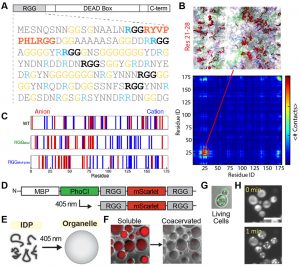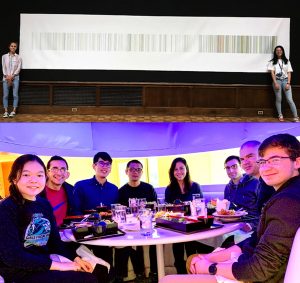
Fig. 1. A. Sequence of disordered RGG domain of Laf-1. B. Coarse-grain simulations identifies hydrophobic motif 21-28 that self-associates for condensation. C. Re-design of charge partitioning tunes phase behavior. D-F. Photocleavable RGG construct undergoes soluble to condensed transition upon 405 nm illum. G-H. Expression and optically induced condensation construct (D) in a model single cell system.
The SuperSeed labs of Hammer and Good designed a disordered protein material called ‘SPLIT’ capable of self-assembly into micron size protein condensates when illuminated with brief pulses of 405 nm laser light [1]. The saturation concentration of these photo-regulated coacervates were characterized biochemically in vitro, and imaging confirmed optically-induced condensation from genetically encoded components in living cells.
Next, our team elucidated the amino acid sequence determinants of Laf-1 RGG domain condensation [2]. Coarse-grain simulations from Mittal and in vitro turbidity and microscopy from Hammer and Good identified a previously unknown hydrophobic batch and determined the importance of Arg and Tyr interactions. Importantly, with this understanding we were able to re-design the polypetide sequence to tune the critical temperatures of phase separation.
1SPLIT: Stable Protein Coacervation using a Light Induced Transition. Ellen H. Reed, Benjamin S. Schuster, Matthew C. Good, Daniel A. Hammer. In Press, ACS Synthetic Biology. 2020
2Identifying Sequence Perturbations to an Intrinsically Disordered Protein that Determine Its Phase Separation Behavior. Benjamin S. Schuster, Gregory L. Dignon, Wai Shing Tang, Fleurie M. Kelley, Aishwarya Kanchi Ranganath, Craig N. Jahnke, Alison G. Simpkins, Roshan Mammen Regy, Daniel A. Hammer, Matthew C. Good, Jeetain Mittal. Pre-print on BioRXIV. 2020

Upper Photo: Hammer lab summer high school students Amélie Lemay (left) and Allison Zhang (right). Lower Photo: Good lab summer high school students Michelle Tong (far left) and Jake Becker (far right)
Our SuperSeed Team is committed to broadening the participation of underrepresented groups and educational outreach to local high school students. The Hammer and Good labs have run high school summer programs at Penn, in which students from a local area high schools train in various experimental techniques, learn the tenets of good research practice, and present their findings at the conclusion of the term. The Mittal Group has existing partnership with Broughal Middle School which has a student body composed primarily of individuals from low socioeconomic status and otherwise underrepresented groups in STEM.
